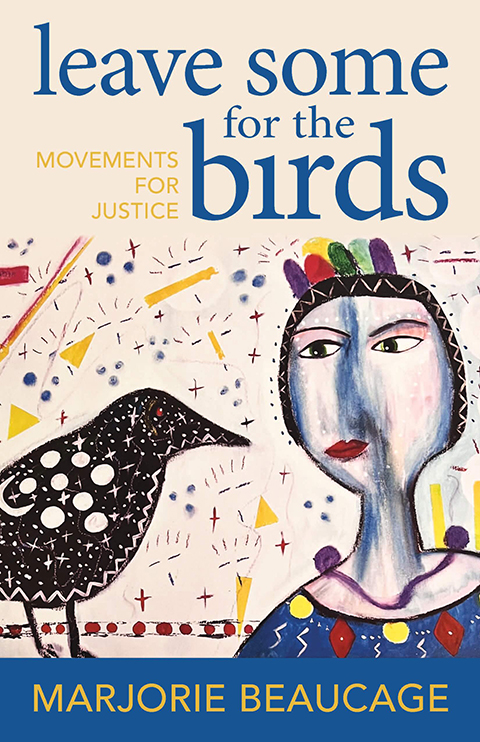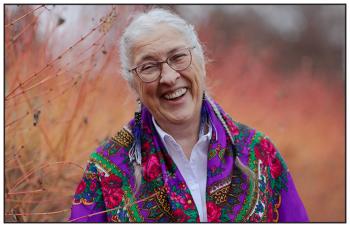Image Caption
Summary
Local Journalism Initiative Reporter
Windspeaker.com
Marjorie Beaucage uses a single word to explain how she feels about having won a Governor General’s Award for her art—“visible.”
It’s an appropriate word as Beaucage was one of six winners announced last week in the Visual and Media Arts category for artistic achievement.
“So much of my work has been community-based and it's not the big-time stuff. But it does make medicine for the people and so by getting this award for all my work over that 30-plus years, I feel recognized,” said Beaucage, Métis from Duck Lake, Saskatchewan.
Specifically, she was noted as a creative documentary filmmaker, nominated by Alyssa Fearon, director/curator, on behalf of the Dunlop Art Gallery, Regina Public Library.
“Deeply devoted to community revitalization, Beaucage works as an artist-educator to tackle difficult topics with groups that have been historically and systemically overlooked,” said Fearon. “Through participatory arts-based projects, Marjorie harnesses the power of art as ‘medicine’ to create transformative change for individuals as well as communities.”
Beaucage’s work over the years has intersected with two-spirit youth, sex workers, survivors of sexual abuse, Indigenous women living with HIV, people experiencing homelessness, and people facing addictions.
“I found my voice and my medium in film,” said Beaucage, who laughs that she “ran away from home and went to film school” at the age of 40. She is now 77 years old.
Up until that point she was involved in popular theatre as a way to use art to protest.
She was thrown into the role of an “art-ivist” when she was 15 years old and she and her family were removed from the bush in southeastern Manitoba. They had lived there until the provincial government declared the area as Sandilands provincial forest and her father, grandparents and uncles lost their cutting rights to a pulp mill.
“That was my first real sense of injustice that I experienced, having to move out of my homeland,” she said. “I thought, ‘This is not fair. This is not right.’ And so that made me stand up and question.”
Not that questioning was anything new to her. She had done that all her life.
“I don't just accept things just because people say so. I have to know why things are the way they are. And there's more than one way of seeing and being in this world. So I really try to understand and ask questions. That’s, I think, my gift that I use for making change,” said Beaucage.
Her first protest was against a pulp and paper company that was polluting the Wabigoon English River system in Kenora with mercury. She stood outside the Winnipeg Art Gallery handing out pamphlets and asking patrons to boycott the exhibition that was sponsored by the company.
Beaucage recalls never having been inside the gallery before because “I just wasn’t into the arts.”
Little did she know that art would become so important in her life.
At film school she discovered the magic of the camera lens and the editing room.
“I think my camera is a witness. My camera is a way of seeing the world and sharing what I see with others,” she said.
She calls it “writing with light… You let that light in and you put light on something and that changes the way you see it.”
But changing the way people see the world doesn’t stop with the pictures she shoots. It continues in the editing room.
“I can look at (the film) in the edit room and that's where I really love to be and put things together in a way that will help people see things differently. I find that process really sacred and very important,” she said.
Over 30 years she has documented many blockades and life events. Her attic is full of those films, many of which are in formats she can no longer find the machines needed to view them.
“(These are) all kinds of things that are archivable. Those people have gone now and I want to give them back,” she said. “I'm looking for archives that are ours, digital archives that we can have, that we can share with each other and not be at the mercy of the corporate Internet. So that's my struggle right now. I’m getting older, I'm not going to be here forever and I need to pass these things on in a good way.”
There is nobody she is mentoring at this point.

In spring 2023, Beaucage came out from behind the camera taking to a different medium, but one much familiar to her from her childhood. Kegedonce Press published her poetic narrative, leave some for the birds: movements for justice. Here’s a link: https://www.kegedonce.com/books/leave-some-for-the-birds-movements-for-…
“I was writing since I was a child, and that was my salvation. I had almost 50 years of journals…and that's what I went through. I wanted to get rid of them and I thought, ‘I'll go through them and see if there's anything that I can pass on,’” she said.
What surprised her in doing that was what she discovered about herself. She found she was consistent in always questioning, although through the decades she had different answers. She found that her anger had been replaced by working towards creative solutions. She found that over time “different things” enlightened or added to “what my core was.”
She says writing her book was a “liberating process.” When she finished, she burned her journals and “it was fantastic.”
At the heart of Beaucage’s book and at the heart of her films is the focus on movements for justice.
“And there's so much injustice in the world,” she said. “Some of the films I made 30 years ago are still being shown because the thing is that it hasn't changed yet. But I think now people are ready to hear it.”
Forest fires. Floods. Droughts. Melting ice caps. Species at risk.
“The earth is crying for (a shift) and we have to respond. So it's sad, but it's also a possibility,” she said.
Beaucage also contends that people are more open to storytelling, whatever media it is, and it “is so critical to this time that we're in and for our voices to be there, because if you don't hear each other’s stories, you'll never change the relations and that's what we have to do.”
Beaucage was one of three Indigenous artists to be recognized this year with the Governor General’s Visual and Media Arts award. She was joined by Greg Staats and Shuvanai Ashoona. Staats is a Skarù:reˀ [Tuscarora], Hodinöhsö:ni’ artist based in Toronto, whose speciality is photography, performance, video installation, and sculpture. Ashoona, an Inuk artist renowned for her detailed pen and pencil drawings, captures the essence of northern landscapes and contemporary Inuit life. They represent half of the awards given in that category.
“I think that our voices are being heard where they weren’t before. And people are starting to recognize that we've been doing this for a long time,” said Beaucage.
As for the woman who is often described as “a two-spirit Métis auntie, filmmaker, art-ivist and educator, a land protector and a water walker,” Beaucage says humbly, “Well, mostly, I'm just Marjorie, right?”
Local Journalism Initiative Reporters are supported by a financial contribution made by the Government of Canada.

